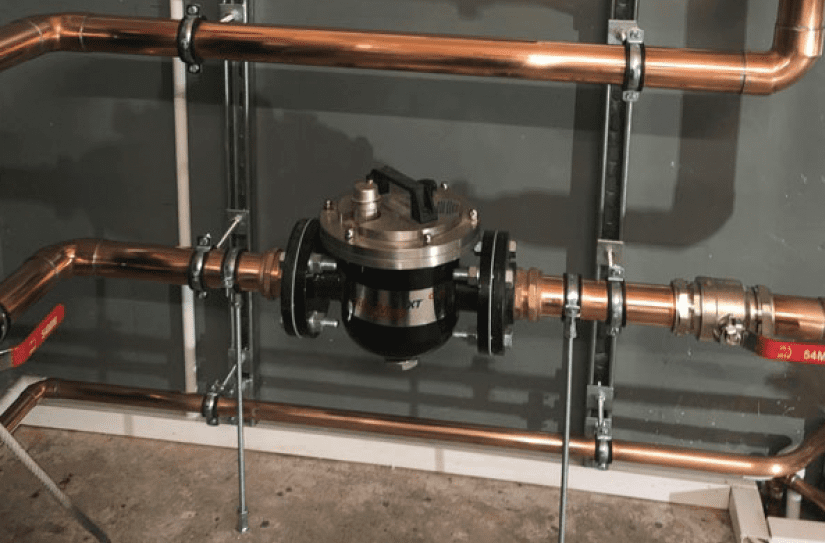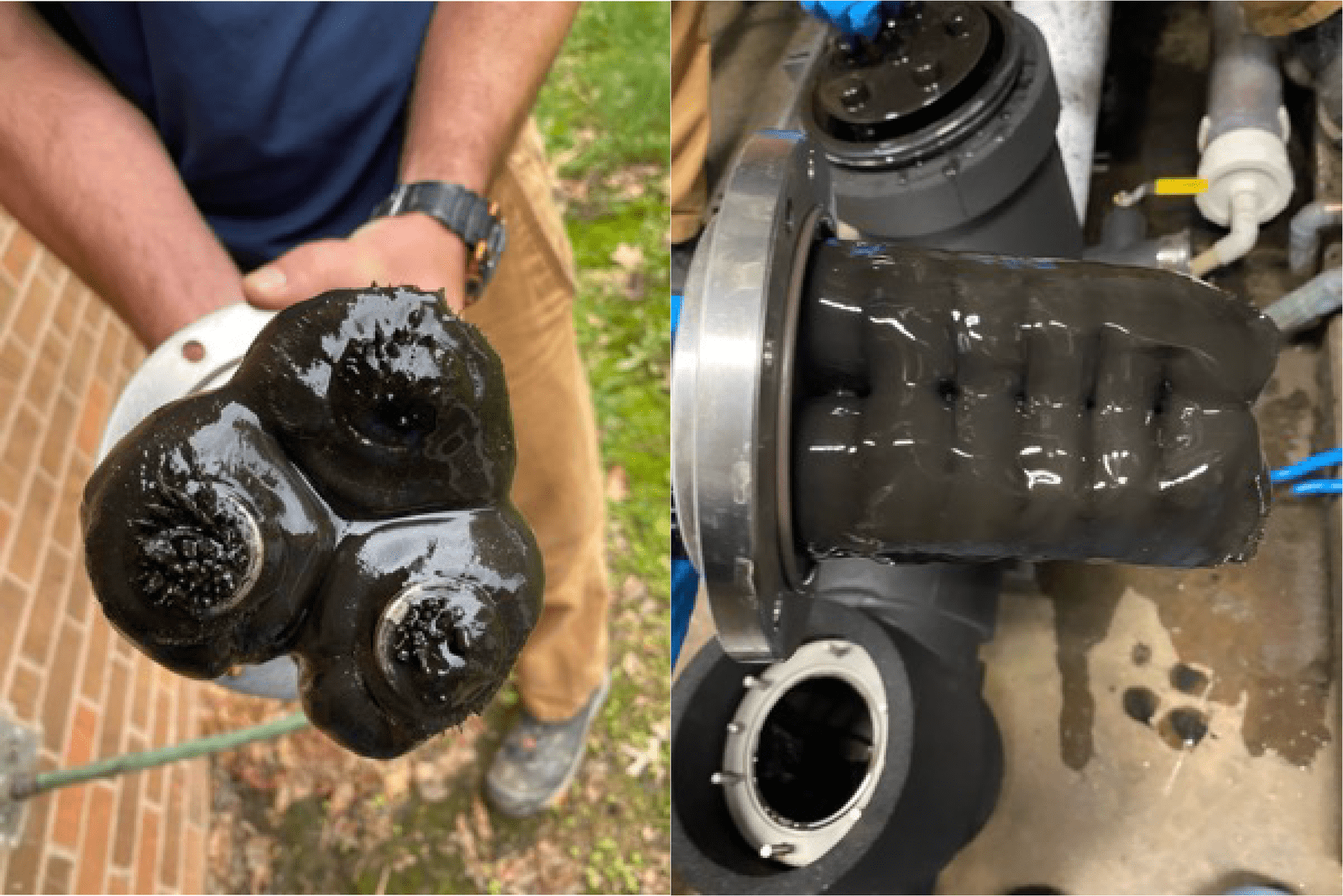Attract a Healthy System with Magnetic Filtration.
How does Magnetic Filtration help?
Magnetic filtration involves the use of a magnetic filter or separator, typically installed in the pipework of the closed-loop system. The magnetic filter consists of a strong magnet or a series of magnets that create a magnetic field. As the fluid passes through the filter, the magnetic field attracts and captures magnetic particles present in the fluid. Magnetic filtration can be paired with pre-existing mechanical filtration and there are several types of magnetic filtration products available.

What are some applications for Magnetic Filtration?
Hydronic heating systems: Magnetic filtration is often utilized in hydronic heating systems, which use hot water or steam to provide heating to residential, commercial, or industrial buildings. These systems typically involve boilers, pipes, radiators, and pumps, where ferrous particles from corrosion can accumulate and affect performance.
- Chilled water systems: Magnetic filtration is also applicable in closed-loop chilled water systems, where water is circulated to provide cooling for air conditioning or process cooling applications. Chilled water systems commonly involve chillers, cooling towers, pipes, and heat exchangers, where particles can accumulate and hinder heat transfer efficiency.
- Geothermal heating and cooling systems: Geothermal systems use the stable temperature of the ground to provide heating or cooling. In closed-loop geothermal systems, magnetic filtration can help remove particles that may enter the system during installation or from corrosion within the underground piping network.
- Solar thermal systems: Solar thermal systems utilize solar energy to heat water or other fluids for domestic hot water or space heating. Magnetic filtration can be employed in closed-loop solar thermal systems to capture particles that may be present in the heat transfer fluid, ensuring optimal performance and system longevity.
- District heating and cooling networks: Magnetic filtration is also applicable in larger-scale district heating and cooling networks that supply heating or cooling to multiple buildings. These networks involve extensive pipe networks, heat exchangers, and other components where particles can accumulate and affect system efficiency.
- Cooling towers: Cooling towers are used to dissipate heat from industrial processes, HVAC systems, or power generation by evaporating water. Magnetic filtration can be employed in the water circulation loop of a cooling tower to remove ferrous particles that can accumulate from corrosion or external sources. By capturing these particles, magnetic filtration helps maintain water quality, prevent fouling of heat exchange surfaces, and reduce the risk of blockages in nozzles, valves, and other components.
- Steam systems: Steam systems are widely used in industries for various processes, such as power generation, heating, or sterilization. Magnetic filtration can be applied in steam systems to remove ferrous particles that can cause wear and damage to steam valves, turbines, and other critical components. By capturing these particles, magnetic filtration helps protect equipment, improve steam quality, and enhance system reliability.
How is Magnetic Filtration Installed?
In general, magnetic filtration can be installed anywhere in a closed loop system that is convenient. Ideally, the best place to install a magnetic filtration device is usually just upstream of the heat transfer surface.
- Determine the installation location: Identify an appropriate location in the system where the magnetic filtration unit will be installed. This is typically in the pipework before critical components like valves, heat exchangers, or equipment prone to fouling or wear.
- Select the magnetic filtration unit: Choose a magnetic filtration unit or separator that is suitable for the flow rate, pressure, and temperature conditions of the system. Consider factors such as the size of the pipework and the expected particle load to ensure effective particle removal.
- Prepare the pipework: Depending on the unit design, you may need to modify or adapt the pipework to accommodate the installation. This could involve cutting the pipework and installing connectors or fittings to integrate the magnetic filtration unit into the system.
- Install the magnetic filtration unit: Mount the magnetic filtration unit securely in the chosen location. Follow the manufacturer's instructions for proper alignment, orientation, and clearance requirements. Ensure that the unit is accessible for future maintenance and cleaning.
- Connect the piping: Connect the pipework to the inlet and outlet ports of the magnetic filtration unit. Use appropriate connectors, valves, and pipe fittings to ensure a secure and leak-free connection. Consider incorporating bypass valves or isolation valves to allow for maintenance or system bypass when required.
- Test the system: Once the magnetic filtration unit is installed and the connections are secure, test the system to ensure proper flow and functioning. Check for any leaks or issues with the installation. Monitor the system's performance and compare it to baseline measurements to assess the impact of the magnetic filtration on particle removal.
- Establish maintenance procedures: Develop a regular maintenance schedule for the magnetic filtration unit. This may include periodic cleaning or flushing of the unit to remove captured particles. Follow the manufacturer's recommendations for maintenance intervals and procedures to ensure optimal performance.

How long does Magnetic Filtration last?
The magnetic filter will eventually become fouled with magnetic shavings. The amount of time this process takes will vary based on the conditions of your system. However, the magnetic filter has a built-in bypass so even when the magnets are fouled, water will continue to pass through the filter.
How often do my Magnetic Filters need service?
The only service required for magnetic filtration is to remove accumulated magnetic shavings. As the magnetic filter removes these fines, over time the interval between cleanings will increase. A clean system may be able to run for months between cleanings.
What systems can use Magnetic Filtration?
Any closed loop system with water and glycol as the heat transfer fluid. Magnetic filtration is available for hot water condensing boilers, heat recover loops, evaporator loops, etc. Any closed loop heat transfer system can be fitted with magnetic filtration.
Is my system too big or too small for Magnetic Filtration?
No. Magnetic filters come in various sizes starting at ¾" fittings for small systems.
Why should I trust Jaytech with my applications that require Magnetic Filtration?
For over 45 years Jaytech has been a leader in our industry. We have been consulting on water systems and water treatment plans to help our customers realize efficiency and longevity in their water systems. We have commissioned and recovered hundreds of systems during that time.
Jaytech is on the cutting edge of innovation in water treatment. Our wide variety of product offerings lends itself to giving our customers a personalized custom water treatment plan like no other water treatment company can. We have created customizable blends of traditional chemicals, ultra concentrates, and solid chemistries. Coupled with our local hands-on approach, Jaytech has earned a reputation as a trusted partner in water treatment.
Jaytech leads the water treatment industry with the most CWTs, the most highly qualified education for water treatment. There is no one more qualified to design a water treatment plan for you.
1. 45-year track record.
2. Extensive customizable water treatment chemicals.
3. Jaytech offers more CWT specially qualified Reps.

